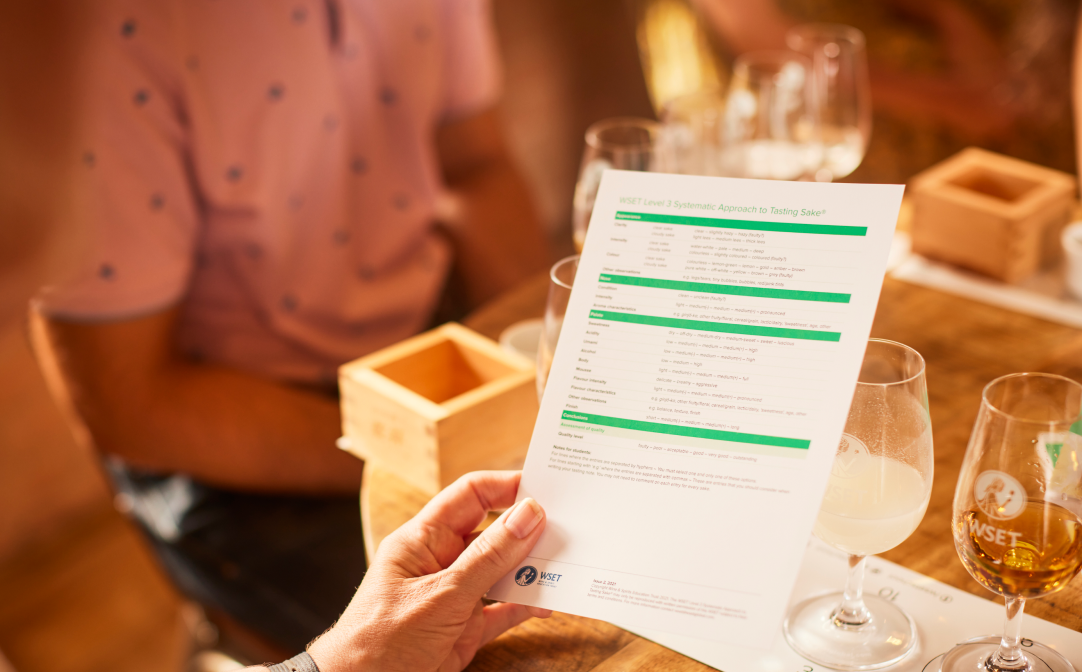For students taking on the WSET sake qualifications, especially those with a wine background, the transition to the sake Systematic Approach to Tasting (SAT) can be unexpectedly challenging. When you’re used to the acidity levels and aromas of wine, you need to make a certain mind shift to embrace the sake vocabulary.
We asked Maksim Polkin, a WSET sake educator based in Tokyo, Japan, for some of the most common pitfalls students face and how they can prepare themselves for the tasting exam that forms part of the WSET Level 3 Award in Sake.
We also interviewed Maksim in 2023 about his career in sake.
Sake is not wine
Maksim started with a simple but powerful reminder: “Tasting sake is close to wine, but it’s not wine.” This distinction is crucial. While the SAT structure may feel familiar, the sensory profile of sake, especially its umami, lower acidity, and unique aroma groups, requires a mental reset.
Students with wine experience often struggle to identify aromas in sake because they instinctively reach for wine vocabulary. Maksim notes, “You’re trying to find the aroma in your wine vocabulary, but it’s not there.” The key is to embrace the sake lexicon, from ginjō aromas like pineapple and melon to lactic and cereal notes, and to let go of wine-based expectations.
The most common mistakes in the exam setting
According to Maksim, the most frequent errors in the tasting exam are surprisingly basic, but can be very costly, like forgetting to write “clear” when assessing clarity. “Students often skip this word and lose a point,” he says. In the WSET SAT, clarity, colour intensity, and colour must all be addressed, even if the sake appears visually neutral.
Writing the wrong aroma descriptors, especially confusing ginjō aromas with other fruity or floral notes, is also a common error. Maksim explains that ginjō aromas are yeast-derived and typically include pineapple, melon, and strawberry. Other fruity notes like banana bread, fig, or orange belong to the @other fruity and floral aromas" category.
It is also important to remember that alcohol is rated only as low, medium, or high – medium(+) or medium(-) is not used in this category. However, acidity, flavour intensity, body and umami can have medium(-) or medium(+) points.
Another area where wine students hesitate is in assigning a quality level. Maksim observes that many are reluctant to label a sake as “outstanding,” assuming it must be rare or exceptional. But in WSET terms, “outstanding” simply means that all five quality criteria (balance, length, intensity, complexity, and expressiveness) can be evaluated positively.
“It doesn’t have to be the best sake in the world,” Maksim reassures. “It just needs to meet all the criteria.”
These may seem like marginal details, but in an exam, they can make the difference between passing and retaking.

The WSET Level 3 Systematic Approach to Tasting Sake
Training the palate: Practice, then practice again
When asked how students can better detect sweetness, acidity, and umami, Maksim is clear: “Practice is the best training.” But not just any practice: it’s important to focus on immersive tasting.
Sake’s acidity is generally lower than that of wine, and its sweetness is often misunderstood. Maksim points out that sake is rarely dry in the same way wine can be. Even the driest styles are classified as off-dry due to residual sugars from the brewing process.
To recalibrate the palate, Maksim recommends intensive tasting over several days. His Level 3 Award in Sake courses are structured as three-day immersions, with students tasting dozens of samples. “By the end,” he says, “they stop comparing it to wine.”
The real challenge: overthinking
Perhaps the most insightful takeaway from Maksim’s experience is this: overthinking is the enemy.
“Stress makes students second-guess everything,” he says. “They start to overthink clarity, colour, aroma groups - and then they lose points.” His advice is to trust your first impression, follow the SAT structure, and avoid trying to be too clever.
He also warns against describing only one aroma group. “You might recognize ginjō aromas, but forget to mention cereal or lactic notes,” he says. “That’s another lost point.”
Preparing for success
To wrap up, Maksim offers a few practical strategies for success:
- Know the SAT grid by heart. This helps you stay structured under pressure.
- Review your tasting notes before the exam. Revisit the sakes you’ve tried and recall their profiles.
- Focus fully during the course. Maksim’s students often cancel all other plans during the three-day intensive. “It’s the best way to succeed,” he says.
- Don’t skip levels. While some students jump straight to Level 3, Maksim recommends starting at Level 2 unless you have strong prior knowledge.
Embrace the sake mindset
With the right preparation, a clear understanding of the SAT, and a willingness to let go of wine habits, students can not only pass the exam, but also develop a deep appreciation for the complexity and beauty of sake.


